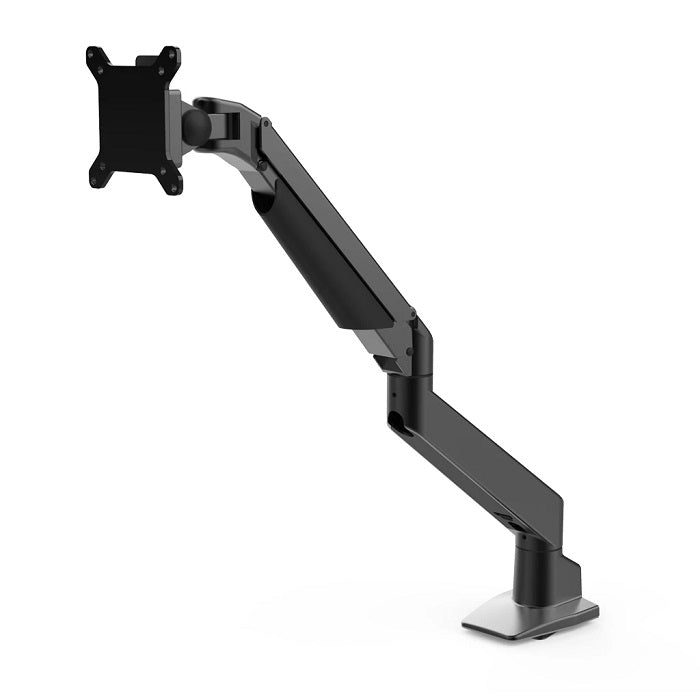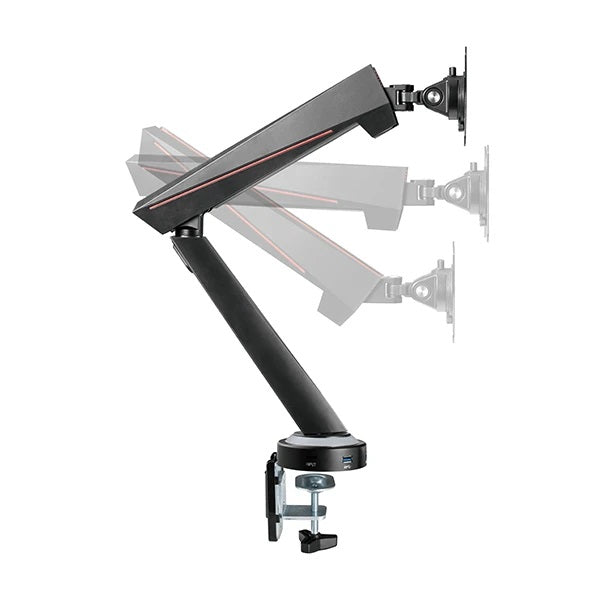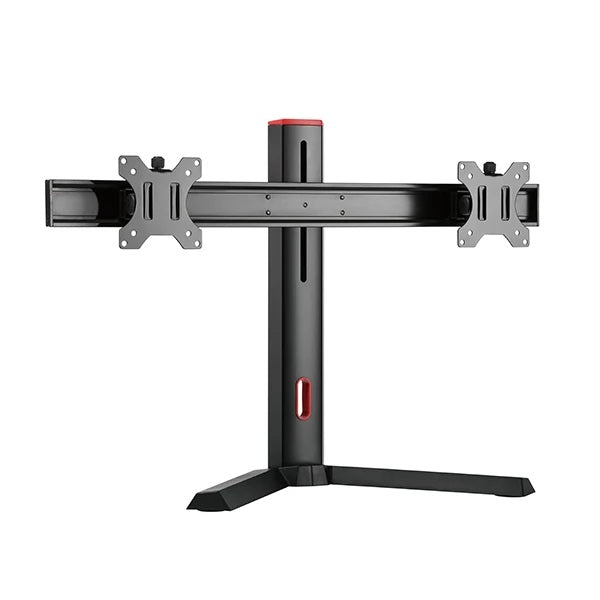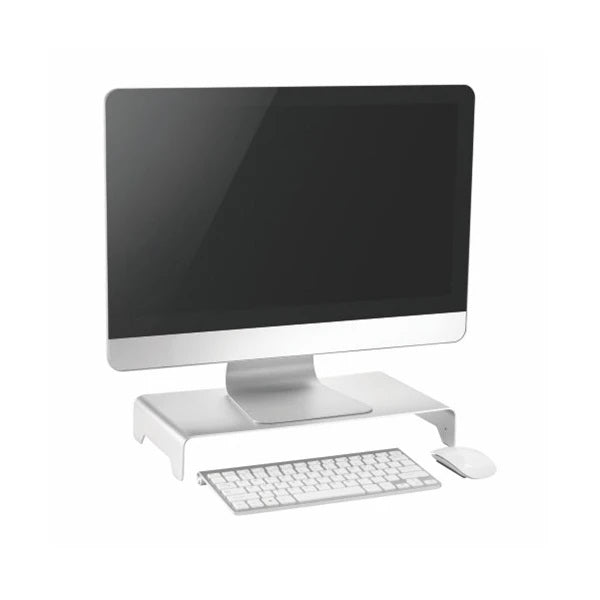We put together this monitor arm guide as we are aware that a lot of our customers struggle to get their monitors set up correctly. If you want to get the most out of your desk, correctly aligning your monitors is crucial. And if stands aren't doing it, a mounted monitor could well be the best solution.
Bad alignment can place strain on the neck and shoulders, which can radiate out down the spine and cause no end of problems. So we figured a monitor arm buying guide was in order. Choosing the best monitor arm for you will depend on your work style, the desk you use and how many monitors you have. We'll cover the dual monitor arm, wall mounts, the monitor mount and monitor stand, and even let you know which hole patterns to look for to identify how to fit your screen. Everything you need to know, to choose how best to optimise your height adjustment and screen position.
Should I Buy A Monitor Arm?
So, before we get into the details of what you're looking for in a monitor arm, let's answer this question: are monitor arms actually worth it? Well, the short answer is, yes, very much so. But it does depend on how you work. If your setup is super minimal, and you don't change often between sitting and standing, or are static, you might get away with using a monitor mount or monitor stand. You can also wall mount your monitors. However, if you have a sit stand desk, the chances are you would benefit from having an adjustable monitor arm as preferred to a more static monitor mount. This way you aren't limited to being able to adjust the height.

A monitor mount, like our Single and Double monitor mounts, won't offer the same flexibility as monitor arms do. Although they are useful to level up your monitors, an arm will allow you more options. Whereas a monitor mount allows for height adjustment, an arm allows movement in three dimensions, as well as from landscape to portrait. For each person, the difference in height between sitting and standing will vary, so the ability to make easy height adjustments is key.
The reason monitor arms are so important is that they allow you to move your monitors to a position where your posture is optimised. In order to keep correct posture at your desk, you need your eyes level with the top of the monitor, with your arms bent at right angles reaching the top of your keyboard comfortably, sat upright, with a natural curve in the back.
If your monitor is too high or too low, the whole thing is knocked out of whack. A stooping position (with the monitor too low) will place strain on the neck and upper back, whereas too high and you'll strain your neck in the other direction. Over time this can lead to pain and discomfort. It can also lead to headaches and all manner of things you don't want while you're working.
The other major advantage is the ability to move position easily. The way you align to your desk when standing and sitting is different, so the ability to adjust your monitor's position easily allows you to switch seamlessly. Our arms also come with an inbuilt cable management system, which you may need to keep your workspace tidy.
What Should I Look For In A Monitor Arm?

When selecting a monitor arm, there's a few important things to look out for, and questions to ask. One we get asked all the time is: do monitor arms work with any monitor? The best monitor arm will be the one that suits you the best. The answer is not so simple. There is almost definitely a monitor arm that would fit your monitors, but they are not all the same.
For the vast majority of people though, our Desky Single Monitor Arm will do the job nicely, or if you have a multi monitor set up our Dual Monitor Arm will be more appropriate for you.
VESA Plate and VESA Compliance

VESA stands for Video Electronics Standards Association, who are the people who make sure monitors are VESA compliant, and designed the standard, 4 mount square VESA mounting configuration (which you can almost certainly see on the back of your monitor). The VESA hole pattern will look like they form a square. To find out if your computer monitor is VESA compatible, look for the square shaped hole patterns in the back. The VESA attachment will work for 95% percent of monitors, which is why all of our monitor arms use this standard unless otherwise specified. If your monitors are not VESA compliant, or you are unsure of the hole pattern, be sure to get in touch to see if we can help.
For users of the iMac, we have designed an iMac Monitor Arm with a specially engineered clamp, as these machines do not comply with the VESA standard.
Number Of Monitor Screens

The amount of computer screens you use is of course going to have a big impact on how you set up your desk, and therefore the amount and types of monitor arms you might need. If you have a dual monitor setup, or even four monitors, you can still use arms for your computer monitors.
If you use two display screens and need to move them independently, then our Dual Monitor Arm mounts both screens on its own arm, meaning you have a full range of movements for both. Our Dual Bar Monitor Arm is the best choice to move your screens in concert.
For super complicated setups, we have added the Quad Monitor Arm, which allows a full range of movements for up to 4 screens on two tiers. And we will be adding a triple monitor arm to the range very soon!

Monitor Weight
The weight of your monitor is important, of course: however, with a weight capacity of 2-10kgs, unless your monitor is 20 yrs old, we're pretty sure our monitor arms will be able to take the strain.
Type Of Monitor Arm Mount
Monitor Arms with Grommet Mount or C-Clamp/Desk Clamp
So, which monitor desk mount to choose? Clamp or grommet? In fact, there are quite a few monitor bracket varieties, ways to desk mount monitors, and various types of monitor mounts in use. If your desk has grommet holes, then you will be able to use a monitor arm with a grommet mount, and attach the monitor arm using the existing hole. It is of course possible to cut your own grommet hole in the desk, if you have a workshop with which to do so.
For most whose desk doesn't have grommet holes though, a C clamp or desk clamp attachment will work best. Monitor arm clamps attach firmly around the back of the desk, or possibly the side, and allow you to alter the monitor's position in 3 dimensions, meaning you can move it closer if the back of the desk is too distant. This also frees up valuable desk space. A quick check of your desk should be enough to figure out which monitor mounts are best for you.
Wall Mount Monitor Arm
Alternatively, you could go wall mounted. If you know you're not moving your desk anytime soon, you can use a wall bracket (or wall monitor bracket) to mount your monitor arm on the wall above your desk. Wall mounts are a great way of keeping desk space free, and can be great for those who need to draw and use their PC during their workday. But even those who just need to save space can benefit from a wall mounted monitor.
Gaming Monitor Arms

Whether it's work or play, the positioning of your display screen is still crucial. When spending any length of time at your screen, you should be thinking posture posture posture. So you definitely need an adjustable monitor. Our gaming monitor arms allow you to optimise your position when playing, so you can enjoy your games pain free. Just like when working, it is crucial you keep the monitor at eye level, so if you change between sitting and standing while playing, a monitor arm will save both time in transition and pain in the long run.
Our gaming monitor arms do all of this, and have the added bonus of adding light and looking great. If you're looking for an lcd arm, our Single LED Gaming Monitor Arm will do for most, but if you're really serious check out our Dual LED Gaming Monitor Arm.
How Much Does A Monitor Arm Cost?
Monitor arms vary in price, and the more screens you need to elevate, the higher the price. That said, you can't put a price on your wellbeing, and saving yourself from pain and long term health concerns in the future is hard to put a price on.
A single monitor arm will be enough for most people, provide a huge amount of flexibility, and isn't going to break the bank. For multi monitor setups, we would always recommend investing too, as it's nearly impossible to achieve the correct posture otherwise (especially when changing positions). Whatever your budget, it's well worth considering a quality monitor arm.
How To Use A Monitor Arm

Fitting a monitor arm to your desk in the home office is of course no use if you don't know how to use it correctly. The position of everything in your workspace needs to be perfect relative to each other, so your monitor, keyboard and mouse must all be positioned correctly. Following the guidelines below will help you to get your computer monitor positioned correctly.
Should My Monitor Be High Or Low?
The ideal height for your monitor is with your eye level just below the top of the screen. Make sure your seated position is optimised too: that means you're sat with your back straight, and your seat at a level which allows your arms to reach the keyboard comfortably when bent at a right angle, with your upper arms parallel with your body. For this reason, a chair with height adjustment (ideally with gas springs so you avoid strain when you adjust the height) is basically essential.
Can A Monitor Be Too High?
Yes, your monitor can be too high. If you feel like you are in an unnatural position, and you're tilting your neck backwards to see your screen properly, then your monitor stand is too high. Over time this will strain the neck muscles, which have the onerous job of supporting your head (which is heavy), leading to a literal world of pain.
How Far Should Your Eyes Be From The Monitor?
How far you should you be from your monitor is, thankfully, very easy to measure. As a yardstick, the length of your arm is roughly the distance you want between your eyes and the monitor.
How Often Should You Look Away From Your Screen?
There are many schools of thought about this, but most people will accept the 20-20-20 rule as at least a good starting point. The 20-20-20 rule states that every 20 minutes, you should look at something 20 foot away for 20 seconds. This will help your eyes to reset and refocus, and should delay the onset of eyestrain.
If you need more help on setting up your desk and monitors, see our Home Office Setup Guide for great advice.
Monitor Mount Alternatives
Monitor Stands

If you don't feel like an arm is necessary for you, that's understandable. However, you should still be very mindful of your posture - even more so if you don't sit/stand, or otherwise vary your position. So investing in a monitor stand means you at least can make the odd height adjustment.

Our Single Gaming Monitor Stand allows you to adjust your monitor height easily, and is also appropriate for work. The Double Monitor Stand does the same thing, but for a pair of monitors, saving you from buying two stands. If you're interested in a monitor stand, check out our full range.
Monitor Risers

Even more minimal than the monitor stand, our Monitor Riser can give your monitor a little boost if that's all it needs! Not so easy to change position, but if you only need to lock in your posture for a few hours at a time this can certainly do a job.
How Long Do Monitor Arms Last?
A good quality monitor arm should provide a good few years, but the amount of usage will be the biggest factor. What's not in doubt is that a well fitted monitor arm will allow you the flexibility to enjoy your work life free from pain, and help you to stay active, healthy and productive. Check out Desky's full range of monitor arms today to see how your setup and health could be boosted!
source https://desky.com.au/blogs/news/monitor-arm-buying-guide

No comments:
Post a Comment